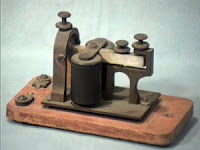This email was sent to all users of the Alberta Museums Association email list on January 4th as an introduction to the Alberta MTC Line project.
Note this project is also known as the Alberta MTC Wire project which is the label used on this site.
~~~~~~~~~~
Happy New Year Everyone!
I am reaching out to you in the Museum Community on behalf of the
Calgary (CG) chapter of the Morse Telegraph club. The club is
dedicated to keeping the sounds of Landline, also known as
American or Railroad, Morse Telegraphy alive.
The Calgary chapter is spearheading a project that will link as
many Museum Telegraphic displays in Western Canada as possible to
a working Telegraph line that runs across the Internet. The
project has been dubbed the "Alberta MTC Line".
I am the instigator and "Wire Chief" for the project and can be
reached through this mail list or at "kevijeps at telusplanet.net"
During 2023 we had several proof of concept demonstrations, the
longest one being a 35 km live connection from Champion Park,
South of Calgary, to the landline telegraph network inside
Calgary's Heritage Park, that links the Midnapore and Laggan
railway stations.
You can read a brief report of that link on the Calgary Chapter's
website here:
https://alberta-mtc.blogspot.com/2023/08/after-action-report-first-active.html
As part of the project we are developing a turnkey hardware setup
that can be easily added to local telegraph displays and networks
to connect them to the Alberta MTC Line.
Development of this combination hardware and software setup is
ongoing and preliminary work has been very promising. The
resulting equipment package should be inexpensive, simple to
configure, and robust in operation.
If your organizations have landline telegraph displays, or you
would like to set one up, and you would like more information on
how to participate in our project, please let me know.
We have 8 museums in Alberta and BC that have expressed an
interest already and we are happy to add more!
We are expecting to begin actively adding stations to the network
starting this coming Summer.
We will also have a proof of concept demonstration running at the
Supertrain event in Calgary on April 20 and 21.
Please reach out to me if this is something your groups and
organizations would like to participate in.
For more information please check out our website at:
https://alberta-mtc.blogspot.com/
We also have a low volume email list with technical information
and hints and tips for people wanting to learn Landline Morse code
here:
https://groups.io/g/Alberta-MTC
Looking forward to a very interesting 2024.
Come and join us!
73 (Telegrapher's code for 'Best Wishes')
Ciao
Kevin Jepson (KJ)
Instigator and Wire Chief
Alberta MTC Line Project
 |
Calgary (CG) Chapter
Morse Telegraph Club |








